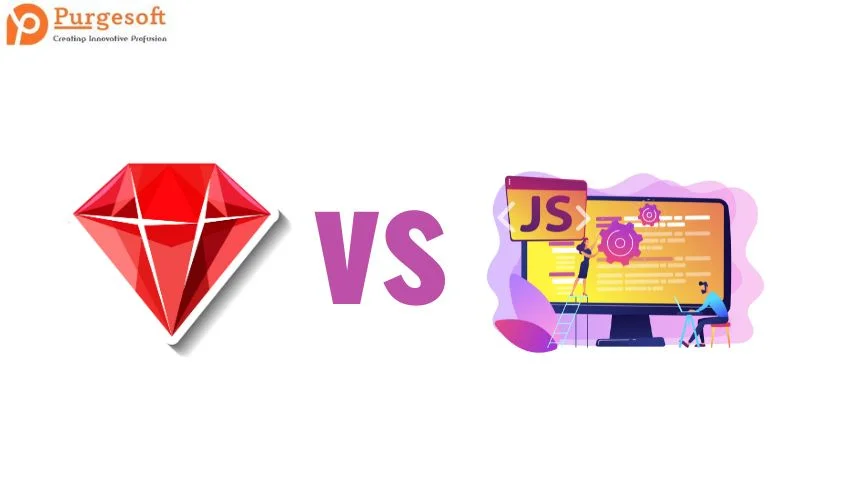
Node Js vs Ruby
When it comes to choosing the right framework for web development in 2023, Node.js and Ruby on Rails (RoR) have emerged as popular options. In this blog post, we will compare these frameworks, considering factors such as their capabilities, performance, community support, and suitability for modern web development. Whether you are seeking Ruby on Rails development services or exploring Node.js for your web development needs, this comparison will help you make an informed decision.
Explained: Node.js and Ruby on Rails
Utilizing the most commonly used frameworks helps with web development. If we talk about their loading times, they are lightning and fast as compared to other languages. Getting to know about both programming languages. You will get to know that Node.js and Ruby on Rails have differences in their features, performance, hosting, and programming languages. Get to know about both Node.js and Ruby on Rail.
Overview of Node.js
Node.js, built on Chrome's V8 engine, enables server-side execution of JavaScript code. Its event-driven, non-blocking architecture has gained immense popularity due to its scalability and high-performance capabilities. With a vast ecosystem of libraries and packages, Node.js offers flexibility and efficiency for building web applications.
Overview of Ruby on Rails
Ruby on Rails, commonly known as RoR or Rails, is a full-stack web development framework that utilizes the Ruby programming language. It follows the Model-View-Controller (MVC) architectural pattern and emphasizes convention over configuration. Rails excel in providing a standardized approach to building web applications, making it a sought-after choice for web development services.
Application Architecture for Ruby on Rails
Ruby on Rails follows the Model-View-Controller (MVC) architectural pattern, which separates the application into three main components:
Model
The Model component represents the application's data and business logic. It interacts with the database and defines the structure and behavior of the data. In Ruby on Rails, models are typically created using Object-Relational Mapping (ORM) frameworks like ActiveRecord, which provide an abstraction layer for database operations.
View
The View component is responsible for presenting data to the users. It handles the user interface, renders HTML templates, and displays dynamic content. Ruby on Rails uses embedded Ruby (ERB) templates to generate HTML views. Views can also make use of partials and layouts for code reusability and consistency.
Controller
The Controller component acts as an intermediary between the Model and View components. It receives user requests, processes them, interacts with the appropriate models, and determines the appropriate views to render. Controllers handle routing, request handling, and business logic flow. They also provide actions corresponding to different user interactions.
The MVC architecture in Ruby on Rails promotes the separation of concerns, making the codebase easier to maintain and test. It encourages adherence to conventions, reducing the need for explicit configuration.
What is Application Architecture for Node.js?
Node.js does not enforce a specific application architecture like Ruby on Rails does with MVC. However, it provides flexibility for developers to choose an architecture that best suits their needs. Here are a few common application architectures used with Node.js:
Single-Page Applications (SPAs)
SPAs have gained popularity with the rise of front-end frameworks like React, Angular, and Vue.js. In this architecture, Node.js acts as a server-side API, serving JSON data to the client-side application. The client-side framework handles the rendering of views and user interactions, while Node.js handles the backend logic and data processing.
Microservices Architecture
Node.js is well-suited for building microservices, where applications are divided into small, independent services that communicate with each other through APIs. Each microservice focuses on a specific functionality or feature. Node.js's non-blocking I/O and event-driven architecture make it efficient for handling multiple concurrent requests, making it ideal for microservices.
Server-Side Rendering (SSR)
In an SSR architecture, Node.js renders HTML on the server and sends it to the client. This approach allows for faster initial page loads and better SEO, as search engines can crawl the fully rendered content. Frameworks like Next.js and Nuxt.js provide server-side rendering capabilities with Node.js, enabling efficient SSR implementations.
Event-Driven Architecture
Node.js's event-driven nature makes it suitable for event-driven architectures, where applications respond to and emit events. This architecture is commonly used in real-time applications, chat applications, and streaming services. Node.js leverages frameworks like Express.js to handle routing and event-driven libraries like Socket.IO for real-time communication.
Node.js vs Ruby on Rails; Get A Comprehensive Understanding
Getting all the key benefits helps with the top and comprehensive understanding while choosing to have the right platform for web development. Get a good understanding of the platform you are going to choose. This guide is from our expert developers, and one can hire Ruby on Rail developers to help with their project. Check all the things for Ruby on Rail and Node.js.
Development Speed and Productivity using Ruby on Rail
Ruby on Rails has long been renowned for its focus on developer productivity. Its convention-based approach streamlines application development by utilizing pre-built components and predefined coding patterns. The extensive set of libraries and gems available in the Rails ecosystem further enhances productivity, enabling developers to deliver projects swiftly.
Development Speed and Productivity using Node.js
Node.js offers the advantage of a unified language across the entire stack, as JavaScript is used for both front-end and back-end development. This allows developers to seamlessly transition between different layers of the application. However, Node.js lacks the built-in conventions of Rails, which may result in a steeper learning curve for newcomers.
Performance and Scalability
Node.js is widely recognized for its high-performance capabilities. Its event-driven, non-blocking I/O model efficiently handles concurrent requests, making it ideal for real-time applications and high-traffic APIs. Moreover, the extensive range of lightweight modules available in the Node Package Manager (NPM) ecosystem allows developers to optimize performance according to specific requirements.
While Ruby on Rails may not offer the same inherent performance as Node.js, it provides a solid foundation for building scalable applications. Rails incorporates caching mechanisms, database connection pooling, and various performance optimization techniques to handle high loads. However, optimizing Rails applications for performance may require additional effort compared to Node.js.
Community and Ecosystem Using Ruby on Rail and Node.js
Both Node.js and Ruby on Rails have active and supportive communities. However, Node.js enjoys a larger community due to its widespread adoption and popularity. The extensive NPM ecosystem provides developers with a vast array of modules and libraries, making it easier to find solutions for diverse development needs.
Ruby on Rails, despite having a slightly smaller community, has a mature ecosystem and a strong culture of open-source contributions. The rich collection of gems in the Rails ecosystem significantly accelerates development and provides robust solutions for various functionalities. When seeking web development services, the availability of experienced Ruby on Rails developers can be advantageous.
Learning Curve and Documentation
Ruby on Rails has long been considered beginner-friendly, owing to its convention-over-configuration principle. Its well-structured documentation and abundance of tutorials and guides make it relatively easy for newcomers to get started. However, learning Node.js may require a deeper understanding of JavaScript and asynchronous programming, which can pose challenges for beginners.
Use Cases and Industry Adoption
Node.js excels at building real-time applications, microservices, and APIs, thanks to its event-driven architecture and high concurrency capabilities. It has gained widespread adoption in the tech industry, with renowned companies like Netflix, Uber, and LinkedIn utilizing it for their backend services.
These are some of the main facts one needs to know for both Ruby on Rail and Node.js. Both have advantages and disadvantages. While developing a web development service to build a web application for your organization.
On the other hand, Ruby on Rails has found its niche in building web applications that require rapid development and adhere to conventions. It is widely used in industries such as e-commerce, social networking, and content management systems. Companies like GitHub, Airbnb, and Shopify have leveraged Ruby on Rails to develop their platforms.
Last words
Node.js and Ruby on Rails have their strengths and are suitable for different use cases. Node.js offers scalability, high performance, and a vast ecosystem of modules, making it ideal for real-time applications and APIs. Ruby on Rails emphasizes developer productivity, and convention-over-configuration, and has a mature ecosystem with a strong community. When making a decision between the two frameworks, it's essential to consider the specific requirements of your project, the skills needed to hire Ruby on Rail developers, and the long-term goals of your application.
Whether you choose to hire Ruby on Rails developers for their productivity and convention-driven approach or explore the flexibility and scalability of Node.js, both frameworks have proven themselves as reliable choices for web development in 2023.
You can connect with our expert consultants at Purgesoft for both Ruby on Rail and Node.js. At Purgesoft, you can hire Ruby on Rail developers and build your web app as your business requires.





